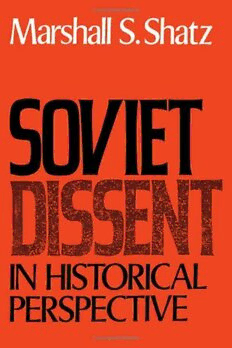
Soviet Dissent in Historical Perspective PDF
225 Pages·2009·2.567 MB·English
Most books are stored in the elastic cloud where traffic is expensive. For this reason, we have a limit on daily download.
Preview Soviet Dissent in Historical Perspective
Description:
This book places the dissent movement in the Soviet Union within the framework of modern Russian history. Professor Shatz outlines the historical and geographical conditions that led to a pattern of autocratic rule in Russia, and traces the sources of dissent in both tsarist and Soviet Russia. Professor Shatz examines the relationship between the Russian state and the educated classes from Peter the Great to the time of the book's first publication in 1980, explaining why the educated elite was the source of dissidents throughout the period. Autobiographical and literary sources are emphasized in an effort to determine the personal roots of dissent in Russia. Professor Shatz explores the family life, education, and life experience of dissidents in an attempt to explain why they became nonconformists or rebels. The first half of the book is an historical overview, dealing with Russia from Peter the Great to Stalin. The second half traces in greater detail the development of Soviet dissent from Stalin's death to the latter part of the twentieth century, contending that Soviet dissent, although it had its own unique characteristics, was the product of a pattern of development Russia has been following since the eighteenth century.
See more
The list of books you might like
Most books are stored in the elastic cloud where traffic is expensive. For this reason, we have a limit on daily download.
